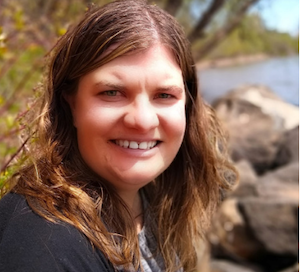Looking Down, Up, Forwards, and Backwards: Telling the Story of the Menominee Sustainable Forest
by Kate Van Haren
Using Images to Begin the Story
“That’s a lot of green!” “Why is that all a darker green than the rest of the area?” “Is that all woods?”
“There must be a lot of big trees!” “Were there ever any trees cut down there?”

I had just given this photo to my fourth-grade students as part of our study of Wisconsin communities. Although I had not shared any background information with my students yet, I had provided them with a satellite image of the Menominee Reservation located in the northwest corner of the state of Wisconsin. Taken over twenty years before the beginning of this lesson, the photo remained one of the best aerial representations of the forest and its surrounding land. This land had not changed much between the time when the satellite flew over the forest and when I talked about it with my students, thanks to the efforts of the Menominee people who live in and around that large patch of dark green. Continuing with the long stream of questions, one student asked, “Is this what Wisconsin used to look like?” In fact, the photo offers a limited sense of how intensely forested Wisconsin, along with most of North America’s Eastern, Midwestern, and Great Lakes regions were before the beginning of settler colonial logging in the 1600s. According to reporter Frank Vaisvilas (2020), “The Menominee Forest on the Menominee reservation is often touted by experts as the largest single tract of virgin, native timberland in the Great Lakes region.”
 Kate Van Haren is a fourth- and fifth-grade social studies and literacy teacher at Pittsville Elementary School in Wisconsin. She is also a doctoral candidate at Penn State University. Her research interests focus on exposing young learners to themes of anti-oppression and civic engagement. In addition to teaching children, she helps create a professional deployment that challenges educators to question their own social studies education backgrounds and create a curriculum based on critical literacy and counternarratives.
Kate Van Haren is a fourth- and fifth-grade social studies and literacy teacher at Pittsville Elementary School in Wisconsin. She is also a doctoral candidate at Penn State University. Her research interests focus on exposing young learners to themes of anti-oppression and civic engagement. In addition to teaching children, she helps create a professional deployment that challenges educators to question their own social studies education backgrounds and create a curriculum based on critical literacy and counternarratives.